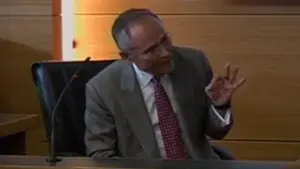

The Expert: Dr. Luis Villa, a hematologist, discussing the patient’s condition, and what led to the patient’s death.

In a Florida medical malpractice trial over the death of a teenager following complications involving deep vein thrombosis, Dr. Luis Villa, a Miami-based hematologist/oncologist, provides key testimony for the defense.
At trial, the plaintiff claims that a more timely CT scan would have allowed for earlier discovery of the patient’s problem. However, Villa discusses the pathophysiology related to portal vein thrombosis and how the process itself makes the diagnosis difficult.
Villa explains to the jury that a clot forms within a blood vessel and, depending upon whether this is an artery carrying oxygen to an organ or a vein carrying carbon dioxide away from an organ, the clot’s symptoms may develop rapidly or slowly. Using the heart as an example, he relates how a blood clot in an artery supplying the heart muscle can damage the muscle by depriving it of oxygen, resulting in an infarction, or dead area. If that infarction is large enough, or involving a critical area, it will result in a heart attack and possibly immediate death.
In this case, Villa says, it was the system of veins that clotted instead of an artery. That changes the presentation, the progression, and the symptoms, but not the final result: infarction of the area affected by the clot. An arterial blockage will cause immediate pain as the affected area becomes ischemic, warning that it needs oxygen soon or it will infarct permanently. On the other hand, the venous circulation supplies a way for the blood to leave an area once it releases its oxygen. If that path for the blood to leave is blocked by a thrombosis or blood clot, blood backs up, eventually slowing the delivery of oxygen where it is needed. Small veins in the area expand to accommodate the blood and move it away. So, unlike an arterial blockage, it is unlikely that there will be a sudden onset of severe pain in a venous blockage of the type seen with this patient. More likely, the symptoms will be much slower to develop and even become intermittent.
This latter characteristic of venous thrombosis is related to the fact that the clots within the veins are forming and disappearing then reforming, so the veins themselves can be opening and closing intermittently. This causes symptoms that are not as sharply defined, severe, or specific. “There is not a classical syndrome,” that is indicative of venous clotting, Villa explains.
Villa confirms that portal vein thrombosis is a rare condition, but that mesenteric vein thrombosis, as was seen in this patient, is even rarer. Since this patient had neurologic difficulties since birth, she had the mentality of a child. This, in combination with the rarity of portal vein thrombosis, added significant difficulty to making the diagnosis.
Portal vein thrombosis is usually seen in patients with liver cirrhosis, chronic hepatitis, or diseases of the blood itself. Congenitally acquired coagulopathies also can cause thrombosis. These people with have an inability to digest clots as the body usually does. The body, after a clot has formed done its job, will usually remove that clot through natural methods. In some people, they do not have the ability to effectively remove that clot, so it continues to exist and enlarge. Others can have acquired conditions that result in clotting too much. This is the case with the patient involved here. She had ulcerative colitis, which promotes coagulation. There has to be some pathological condition or traumatic event to lead to the clotting of these veins.
The process of clotting is a progression, Villa explains. The body creates clots as it needs, and the clots become larger and spread. At the same time, the body begins lysing, or dissolving parts of the clot that are not needed. This process takes time.
The doctor points to the clot in question and says that it could be up to 8 weeks old. He then points out clots behind the older clots and says that they are likely a day, a week, or ten days old. Finally he points out that the autopsy did not report on the newest formed clots that he is certain would have been found in the superior mesenteric vein feeding into the portal vein. This was apparently not reported because, from the standpoint of determining the cause of death, that was not the important factor to the pathologist performing the autopsy.
However, several segments of intestine had infarcted from lack of adequate blood supply; this is why she died. Knowing that there was thrombosis of the portal vein, and finding the intestines dead on autopsy, one could assume thrombosis of the mesenteric vein that feeds into the portal vein and drains those segments of intestines. That was the final insult causing completion of intestinal infarction.
Villa concludes that this process would have taken days or weeks in its development, the symptoms would have been variable and deceptive, and they would have been difficult to interpret given the patient’s mental status. The jury agreed, rendering a verdict for the defense.
Gary Gansar, MD, is residency-trained in general surgery. He served as Chief of Surgery and Staff at Elmwood Medical Center and on the Medical Executive Committee at Touro Infirmary and Mercy Hospital in New Orleans, LA. Dr. Gansar was Board Certified in general surgery while in active practice. He joined AMFS in 2015 as a Physician Medical Director.
The medical expert witness partner for attorneys serious about building a winning case
AMFS is your trusted source for highly-qualified medical expert witnesses. After pioneering the field nearly three decades ago, we’re continuing to redefine medical expert witness services by providing value far beyond a referral alone.
Our Physician Medical Directors know what it takes to build a strong case. Our medical expert witnesses leave no doubt. And our case managers streamline billing and logistics every step of the way, letting you focus on what you do best: constructing your winning case. Explore why AMFS clients expect more from their medical expert witnesses—and get it.
